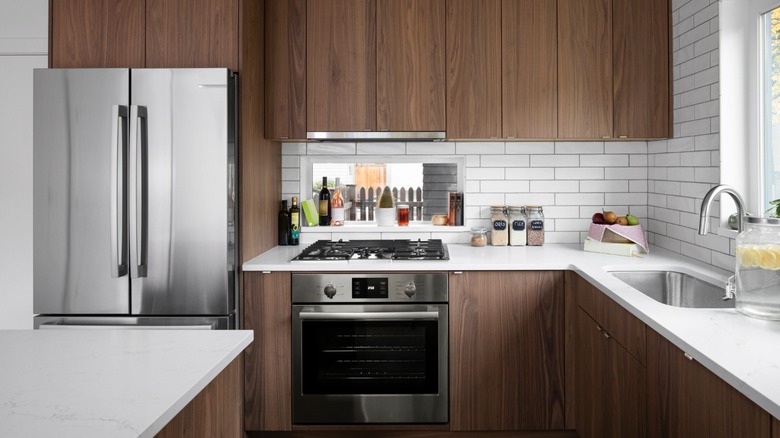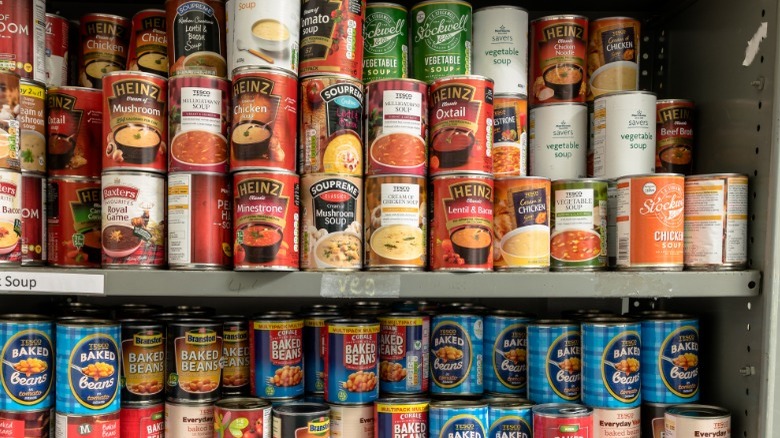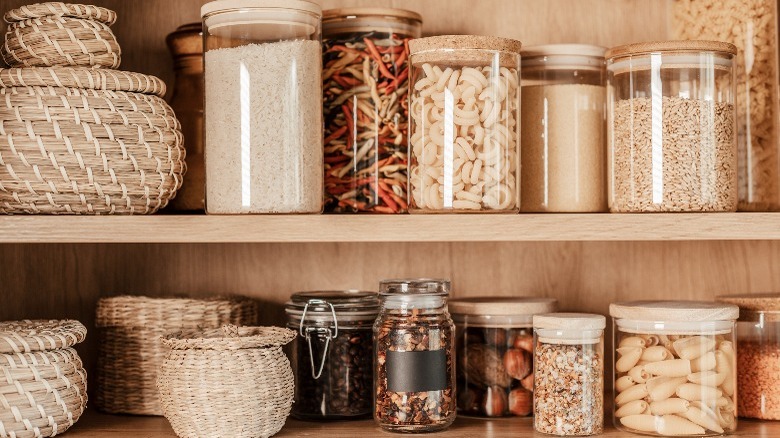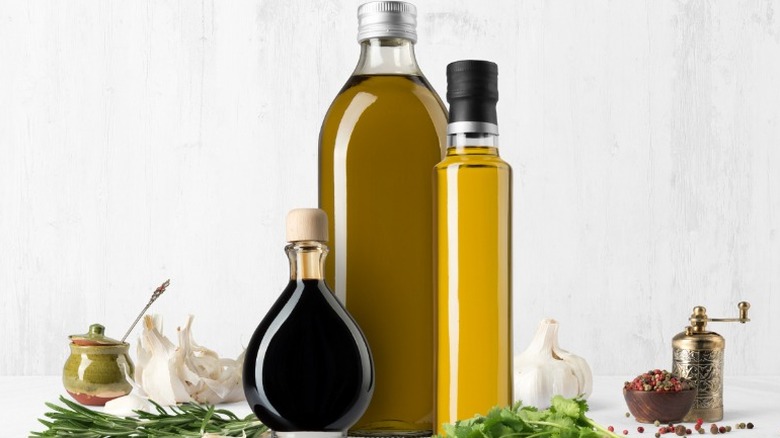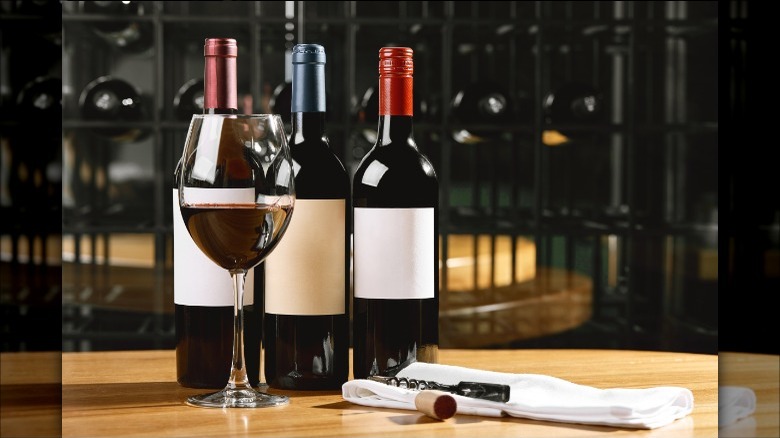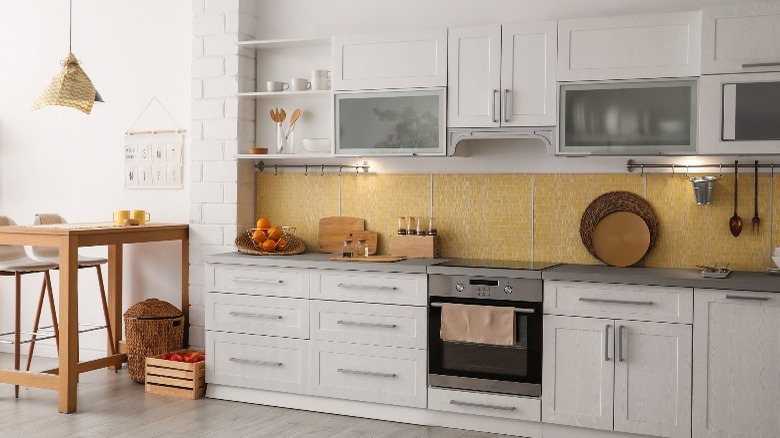Why You Shouldn't Store Food In The Cabinet Above The Stove
Home cooks are always looking for the best ways to use every possible inch of their kitchen's storage space. Some look to the cabinets above the stove as a great opportunity to put things away, but this area presents an array of challenges. These cabinets tend to be on the smaller side, and they are often obstructed by the stove's exhaust fan. This would be an unusual and difficult space to organize in any room, but its placement in the kitchen creates a unique set of concerns: Sitting above the stove means that these cabinets have some exposure to heat and moisture from the cooking done below.
Clearly anything perishable wouldn't be a good fit for these cabinets. Some like to use this space for storing other kinds of food, suggesting that this might be the ideal spot for canned goods, certain liquids, and even spices. On the surface, these may seem like good ideas — but after further investigation, it turns out there are some potential hazards involved in putting anything edible in that awkward spot above your stove.
Not a great spot for canned goods
At first, the cabinets over the stove may seem an ideal location to store canned foods. Why not use that space to put away the 8-pack of black beans you bought on sale? It turns out you should give your can a better home as a matter of food safety. While canned items can have a long shelf life, where you store this stuff on really matters. According to the U.S. Department of Agriculture's Food Safety and Inspection Service, you should never put canned items near or above the stove.
Canned goods aren't designed to weather extreme temperatures or temperature fluctuations. In fact, cans prefer environments that are stable and less than 85 degrees (fahrenheit). Storing cans in spaces that reach over 100 degrees may cause the food to spoil. Humidity may also do a number of your cans, leading them to rust. That's why the USDA says it's best to put these items in a cool and dry place.
Keep other packaged foods away from heat
Above the stove might seem like a good spot for dry packaged foods, such pasta and grains — they seem so durable after all. And the long, but thin boxes of spaghetti or bucatini could fit nicely in the cupboard. Unfortunately, exposing dried pasta to heat and humidity that comes off the stove top may shorten its shelf life. Grains have a similar aversion to higher temperatures, and some whole grains will actually last longer if kept in the fridge or freezer. To get the most out of your pantry purchases, keep them in a cool, dark place.
The shelves over the stove may seem like an ideal location for another popular dried item: spices. If you want your seasonings to last and maintain their flavor, you're going to want to pick a different place to house them. Like most edible items, spices do better in cool, dry, dark places because heat, light, and humidity can speed up the aging process. Your favorite herbs will lose their kick faster if left in a hot spot.
Oils and vinegars don't like the heat either
Some have suggested that the above-the-stove cabinet might be a great place for cooking oils and vinegars. Theoretically, it would be a handy location for these items, but there are other factors at play that will make you want to reconsider this idea. As Mary Mori, California Olive Ranch's vice president of technical services, explained to Real Simple: "There are four main enemies of cooking oil –- time, heat, oxygen, and light." And the cabinet above the stove has an abundance of one of those.
Olive oils can be quite fragile, preferring to be stored in a cooler space, around 65 degrees. Even more hearty oils, such as vegetable oils, have their quality impacted by heat. Most oils hold up better for longer if they are kept in a cool environment in a dark place like a cupboard. And like cooking oils, vinegars don't fare well around heat either. Exposure to heat, light, and air can change the flavor of your favorite vinegars.
Keep alcohol cool
From a design perspective, it might look nice to take the doors off the cabinet above the stove and put in some type of wine rack. But if you do this, you'll soon discover that what looks good doesn't always taste good. There's a reason why people shell out money to buy special refrigerators for wine, and that's because it's very sensitive to temperature, ideally being in a place that's somewhere between 45 degrees to 65 degrees. Exposure to too much heat may ruin your wine and you'll end up with a potentially pricey bottle of vinegar.
Like wine, liquor doesn't love the heat either. While it's fine at room temperature, you don't want to put it in the warmest spot in your kitchen. Being kept at a higher temperature can cause your favorite whiskey or gin to start to taste differently. Some alcohols actually need a cooler environment –- fortified wines and cream-based liqueurs last longer and keep their flavor better if refrigerated.
What to store above the stove
While storing food above the stove isn't a wise move, there are lots of other items that will work for this space and help you maximize your kitchen storage. Think about what you use infrequently or seasonally. This would be a good place to stash those single-use tools, like a pineapple corer, out of the way. It's also the ideal spot for your less popular kitchen gadgets, such as a spiralizer or a popcorn popper, or all the special attachments for your stand mixer or food processor.
Some people like to use it to house their seasonal dishware, such as holiday-themed coffee mugs or dessert plates. It's also a nice location for food storage containers, allowing them to be right on hand when it's time to put the leftovers away. Things like rolls of aluminum foil, plastic wrap, or parchment paper could work here, too. Another interesting suggestion is to make the space above the stove into a little culinary library by storing cookbooks there.
